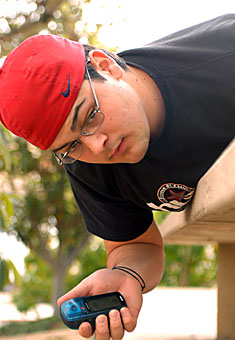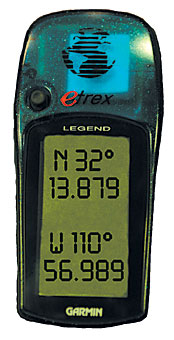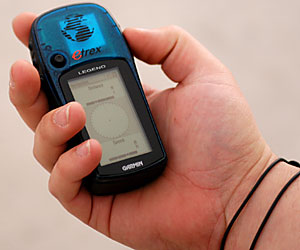 |
|
CLAIRE C. LAURENCE/Arizona Daily Wildcat
|
Political science senior Chuck Coolidge demonstrates his "geocaching" skills on campus yesterday as he looks under a bench. Coolidge is one of the many Tucsonans who participate in the little-known hobby that involves tracking down hidden treasures based on GPS coordinates.
|
|
|
By Jessica Lee
Arizona Daily Wildcat
Wednesday, March 3, 2004
Print this
Students use GPS units to hide, find objects on campus
When darkness hides corners of campus in shadows, people creep around the UA with only one goal: to find hidden treasures.
People using nothing but intuition and satellite data find these treasures, or "caches," using Global Positioning System coordinates on their hand-held GPS units.
A GPS unit, about the size of a cell phone, pinpoints a location using a worldwide ratio-navigation system that collects data from satellites and their ground stations.
Called "geocaching," the activity involves hiding containers and posting its GPS coordinates at geocaching.com.
Others then log onto the Web site, get the cache coordinates, and enter them into a GPS unit. If they're lucky, there might also be a clue posted on the site.
"It's like an international scavenger hunt with everyone and anyone. But, it's still nerdy," said Jenny Bentley, an art education senior who geocaches with her self-declared nerdy boyfriend.
 |
|
Want to find Team Car-RamRod's cache?
Enter these GPS coordinates and follow the hint in the article.
|
|
|
The term "geocaching" is derived from the "geo" in geography and "caching" for the activity of hiding or finding a cache.
The caches can be as small as a film container and as large as a chest or bucket. The size depends on where it needs to be hidden; urban caches are generally smaller, so they are not seen by general passers-by.
Inside the cache, objects include a log sheet and a few trinkets or other prizes. If an object lures the geocacher, it can be traded with another trinket of equal or greater value. Food items and illegal objects, such as drugs, are not allowed.
Chuck Coolidge, a political science senior, spent Monday night poking around the Aerospace and Mechanical Engineering building looking for a cache that had been hidden nearby.
Coolidge, who has found many caches around Tucson but had yet to conquer all the campus locations, embarked on his quest with his GPS unit and a clue from the Web site that read, "Obstructed by the palm."
As Coolidge stepped cautiously around the AME building, following the compass on the GPS that would lead him to the cache location within approximately 20 feet, he explained some geocaching ethics.
"The big thing is you don't want to get caught," Coolidge said. "A big rule is to keep the cache safe."
Etiquette requires all geocachers to not draw attention to themselves while looking for objects that could be stashed in bushes, attached by magnets to stairs, hidden under objects or stuck in trees.
"The point is to be discreet. If someone comes around, you can pretend you are on your cell phone or something," Coolidge said.
 |
|
CLAIRE C. LAURENCE/Arizona Daily Wildcat
|
A GPS unit, like the one here, is about the size of a cell phone and can pinpoint a location using a worldwide ratio-navigation system, helping geocachers find hidden treasures.
|
|
|
He is a member of the geocaching team, "Car-RamRod," which includes him and two of his friends. Team Car-RamRod has become quite competitive, especially with Team FuManChu, which it has never met.
"They hide really hard ones. Once we found one in the Tucson Mall," Coolidge said. Hiding caches indoors is generally not welcomed because GPS readings are poor. "So, we hide hard ones for them."
Nathan Knutt, a UA law student, has managed to make time between studying to pull out the GPS and hit the city.
"Honestly, at first I thought that it sounded a little odd to go around town trying to find things that other people have hidden," Knutt said. "It sounded like a big game of hide-and-seek, without all the yelling and screaming, which is half of the fun."
After about 15 minutes of looking, Coolidge found the AME cache. The cache was an Altoids can spray-painted to match its location. Inside were a tiny tan muscleman figurine and a stack of tiny yellow sticky memos, where he signed his team name.
Team Car-RamRod decided to trade a red plastic spider for the muscleman, an exciting find for the team. The trade was documented in the little logbook.
Outside Tucson, the mountains and desert provide an infinite amount of cache stashes.
"The (cache) in the desert was probably the trickiest because we had to avoid the cacti and dig under some wood before we found the cache," Knutt said.
For Bentley, hiking around in the desert led to a strange situation.
"We hiked a bit off of the road. It felt really creepy. Once we were out there looking around, we found some clothes, a duffle bag and a sleeping bag. All of the stuff was really dirty and torn up," Bentley said. "This is the type of thing you go out and do, and end up finding a body somewhere."
The geocaching challenge is undertaken by individuals of all ages, not just college students.
"I like it because I get to take my kids out in the desert instead of them watching TV," said Gary Christopherson, the director for the UA Center for Applied Spatial Analysis. He has not looked for any on campus.
Some geocaches involve just finding one cache container, while others are "multi-caches" that involve many clues. Another type is the "webcam cache," in which credit for finding the cache involves having a teammate watch a webcam on the geocache Web site and printing out the picture once a teammate is seen on camera.
Old Main is being constantly filmed by a webcam cache.
Since geocaching became popular in 2001, more than 100 caches have been hidden in the Tucson area.
Until Coolidge stepped on campus Monday night, there were only three known geocaches on campus.
Now there are four.
Hiding geocaches can be just as tricky as finding them.
"You don't want to hide in spots where landscaping people might find them," Coolidge said, as he poked around buildings in the center of campus.
"Now that I do it a lot, I'll be walking to class and say to myself, ╬Ooh, there's a good spot,'" Coolidge said. "Some people hide them near where they work so they can watch people during the day."
As for the new cache that Coolidge hid on campus, he can only tell fellow geocaching students who look for it to "bear down."
